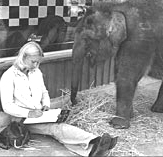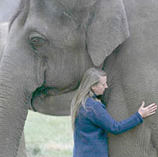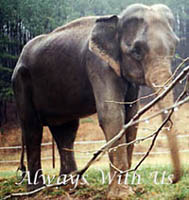June 17, 2010
Babe, Forever In Our Hearts
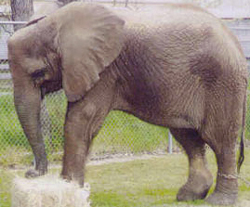
A beloved African elephant resident dies.
The Humane Society of the United States / The Fund for Animals
Memories of Babe, Caregivers and volunteers share their tributes
~
Wildlife Corridor Gives Endangered Elephants In India Passage Between Reserves
Bangalore, 20 December 2007
More than one thousand wild elephants have been given a right of passage today, with the safeguarding of a wildlife corridor that links two reserves in Karnataka, Southern India. The land was handed over by the International Fund for Animal Welfare (IFAW) and the Wildlife Trust of India (WTI) (www.wti.org.in) to forest officials in a ceremony in Bangalore – the first time land has been bought by a non-profit wildlife organisation and signed over to the government to protect the habitat of the endangered Asian elephant.
More than one thousand wild elephants have been given a right of passage today, with the safeguarding of a wildlife corridor that links two reserves in Karnataka, Southern India.
~
Subject: New Baby Born
Date: 9/25/2007
Dear Miss Jody:
Kamprai has given birth to a male baby just five minutes past midnight last night. Both mother and the baby are fine. Kamprai had shown sign since the evening of Sat 22nd September. We are so glad that she accepts her baby well within eight hours. I have named the baby "Zeno" since his elder brothers' names are Songkran and Auro. I thought it would be nice to have this name for him.
The photos will be on the website soon.
Cheers!
Soraida
Friends of the Asian Elephant [FAE]
~
New Baby Born at FAE Elephant Hospital
5/2/2005
Mae Boon has delivered her first
offspring with no
complication.
Mae Boon is a working elephant at a tourist elephant
camp in Chiangmai,
north of Thailand. She showed signs of contraction
since the 13th April
and ate less. The owner brought her to us later on the
19th April for
fear some thing was wrong.
Mae Boon was unable to lie down to sleep the first
two nights but
after adjusting to the friendly atmosphere with other
mother elephant,
Kamprai and baby Auro, Mae Boon managed to rest at
last.
Early morning of the 27th April
at 04.12 a.m. she delivered a healthy female baby.
Baby 'Aura', as I
named her, stood by herself after thirty three
minutes, had her milk at
05.17 a.m. Mae Boon was apparently weak so we gave
her intravenous and
later in the day could nurse her baby.
Other Patients
Our five permanent residents are doing just fine.
Other new patients
including two babies aged three years old have wounds
on their feet. Two
tuskers with gun shot and others. The landmine
victims are also
improving.
Kindly visit our web for more information. It is
going to be updated
soon.
For the elephants,
SORAIDA SALWALA
Friends of the Asian Elephant
[FAE]
~
Wankie, Last of 3 African Elephants Dies in Utah
Monday, May 02, 2005
"We wouldn't expect an elephant this age to die," Lincoln Park Zoo spokeswoman Kelly McGrath said. "If we did, we might have looked at alternatives to moving her. We moved her because it's not good to let these animals live alone."
Wankie was one of three female elephants acquired by Lincoln Park Zoo from San Diego in 2003.
Officials at Lincoln Park Zoo decided to transfer Wankie after the other two elephants recently died within months of each other.
A veterinarian and two elephant keepers accompanied Wankie on the 1,400-mile journey from Chicago to Salt Lake City, McGrath said.
The pachyderm appeared healthy as she was loaded into a truck on Friday, but zoo officials became concerned when she laid down during the trip.
"Elephants can't lay down for long periods of time," McGrath explained. "That can cause tissue and muscle damage in their legs. So this was a major concern."
After they arrived at Hogle Zoo, Wankie was put in a sling and appeared to be fine, McGrath said. Several hours later, however, the elephant began struggling to breathe and a decision was made to euthanize it.
Earlier this year, the oldest African elephant in the United States, Peaches, died at Lincoln Park Zoo at the age of 55. Tatima, a 35-year-old female elephant, died in October from a non-contagious disease similar to tuberculosis, according to zoo officials.
~
Illegal Elephant Trade Thrives, Driven By Zoo Demand
by
Soraida Salwala, Founder, Friends of the Asian Elephant, Thailand
The screams from a baby elephant trapped in a pit are something that will stay with you for life.
So is the sight of an elephant – one of the largest mammals on earth – hobbling into a truck with its foot nearly severed from a steel trap.
These sights and sounds are becoming more and more common in Thailand, where the demand for elephants from western zoos and theme parks is helping to drive the illegal trade in these magnificent creatures.
Unless people can be made aware of what is happening in Thailand and other elephant range states, the future of the Asian elephant in the wild looks bleak.
Despite an international convention designed to limit trade in endangered species (the Convention on International Trade in Endangered Species of Flora and Fauna – CITES) the live trade in elephants is escalating.
When I started my Foundation in 1993, baby elephants were sold for $A1600. Today they can fetch up to $A16,000. The elephant trade is big business.
Meanwhile, the number of Asian elephants in the wild is dwindling and the population is now less than 2000.
Currently there is a request by Sydney’s Taronga Zoo, as well as Melbourne and Auckland zoos, to import nine new Asian elephants from Thailand. They want the elephants to start, what they say, is a ‘conservation’ breeding program.
I find this very puzzling because zoo elephant breeding programs don’t work.
On average, elephants in captivity produce only one calf in their lifetime, compared to wild elephants that give birth to up to six. In zoos, female reproductive cycles are shortened from 30 years to approximately seven.
The rate of stillbirths, rejection of calves and infanticide - which is mothers killing their babies - is also much more common in zoos than in the wild.
In the event these zoos do produce a calf, they can’t release it back into the wild. The proposed zoo captive breeding program is purely aiming for a self-sustaining zoo population.
So where is the conservation benefit in this?
I travelled to Australia to join IFAW and the Wildlife Trust of India to highlight the plight of the Asian elephant and to ask the Federal Minister for the Environment, Senator Ian Campbell, to refuse a request to import nine elephants from my country to zoos in Australia and New Zealand.
Not only is the import questionable under CITES, but it does not meet Australia’s obligations under the Environment Protection and Biodiversity Conservation Act 1999 which sets out strict criteria for the international trade in wildlife between your country and others.
If Australia is serious about helping its neighbours conserve the elephant, then importing them from Thailand is not the way to do it. The demand from western zoo’s for more elephants drives illegal trade that which threatens the species in the wild.
Thai people are delighted that Australia wishes to help preserve the Asian elephant but this can only be done by working to protect the species in its native home, in its native climate and in its native habitats.
There is only one correct decision that can be made –the Australian Government must reject the current request to import nine ‘fresh’ elephants, which I understand will include a baby of only four years of age.
These elephants belong in their home range. Only by protecting elephants in Thailand can the future of the species be assured.
~
November 17, 2004
Lota is home
Thank you Carol, Thank you Scott.
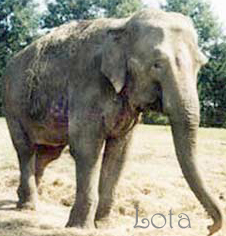
Bless you Lota!
Lota brought her friend Misty along,
a sweet, curious, energetic chubster more than ten years her junior..
Thank you Lota
Bless you Misty!
~
Elephant Saves Companions
United News of India Monday November 15, 2004
PATHALGAON, (Chhattisgarh):
It was a sight straight out from the Jatak tales. An elephant crushes the wall of a well to rescue his pachyderm companions.
Four wild elephants had accidentally fallen into a well while they were straying in Tendugudi village near Pathalgaon yesterday. One else of their group who was standing nearby realised the seriousness of the situation and started pushing
the wall of the well with his feet.
This created an alert and some villagers gathered around. A team of forest officials also reached the site but stood as mute spectators.
The elephant, which was getting restless, started pushing the wall with all his strength and finally a big portion of the wall caved in.
The elephants came out by climbing on each other's back.
District forest officer RK Kaisar said the villagers had tried to drag out the wild elephants and in an attempt to escape the elephants fell into the well.
~
50 kg Ivory Recovered in Jharkhand
[India News] Ranchi, Nov 14, 2004
The recovery of 50 kg of ivory from a house in Jharkhand has led forest department officials to fear that ivory smuggling in the state is continuing on a large scale.
Ranchi police raided a house in Khuti sub division, 30 km from the state capital, and recovered four pieces of ivory weighing 50 kg and arrested the son of a retired army man Saturday.
"The market price of ivory is Rs.10,000 per kg. On a tip off we raided a house and arrested Bandhu Munda of Senegutu village," said Madhusudan Bari, deputy supintendent of police, Khuti.
"The smugglers were planning to take the ivory to Kolkata to sell it. In the past we had information that the ivory was smuggled from Ranchi to Kolkata. The arrested person is being interrogated and we will very soon arrest other members of the group," Bari said.
Four tuskers were found killed in Jamshedpur district last month. Police have said the involvement of Maoist extremists in the poaching of tuskers in some cases has been confirmed through the confession of some of the arrested extremists.
Two tuskers were found killed with their tusks missing in Torpa block on July 18 this year. Torpa block is 70km from Ranchi.
According to forest department sources, about a dozen tuskers are killed by poachers every year but police are not able to trace the poachers. The tuskers are mainly killed in the areas bordering Orissa and Chhattisgarh.
In the past four years 47 tuskers have been killed. Forest department officials claim the population of elephants in the state is 750.
Ranchi Police Seize 50 kg of Elephant Tusks
[India News]: Ranchi, Nov 14, 2004
The Ranchi police today seized four elephant tusks weighing 50 kg from poachers. They also arrested two persons during a sting operations with police officers posing as international buyers.
The men are believed to be from a local criminal gang, which has been attacking pachyderms in forests near the capital city.
Police say, the elephants lured by fresh crops, often flock villages during this season and the locals used to tip the gang about their whereabouts. "The local criminal gangs are involved in the poaching of elephants. The elephants often come into the villages and destroy the crops and sometimes even kill the locals. This time of the year they are more frequent," DSP Madhusudan Bari said.
~
TINY

July 7, 2004
Today around three p.m., a sick baby (aged a year and five months old) arrived at FAE's Elephant Hospital.
The first diagnosis was haemoragic. We were told that the baby's name was DUI-DUI. We tried our best to save him but his temperature dropped and he was gone within an hour.
It was one of the saddest things that happened. The baby was the one whom we saved last year when he was only a day old. His mother is Paitoon. Hope you remember him, I named him TINY because he weighed only 30 kilogrammes.
When his owner wanted to take him back , I opposed. Even though TINY became a big baby but he was only six months old. The owner sold him to a new man and they changed his name. He had grown up so much but we recognized him.
Poor Tiny!
We shall bury him tomorrow and plant a tree on his grave. The tree would grow big to give shade for other elephants, Bigger than TINY himself and I am sure he will be happy to be always remembered as the branches of the tree reach out to the sky.
He was once a joy to us all.
My grief!
Soraida Salwala
Friends of the Asian Elephant
|
Elephant Dreams
Laura Linklater
"Elephant Dreams" |
~
The Elephant Sanctuary in Tennessee
Tange's New Look
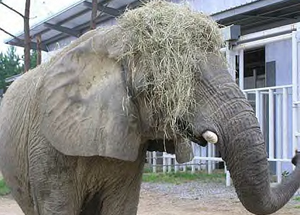
~
Update on LOTA and “the Hawthorn 16” - August 16, 2004
On August 16th Suzanne Carr, The Elephant Sanctuary Project Manager, contacted Jim Rogers, Public Affairs Officer of the USDA, in regards to the August 15 deadline for placement of the 14 remaining Hawthorn elephants, Rogers stated that John Cuneo has made two motions:
Motion to compel enforcement of consent decision and order
Motion to vacate the consent decision and order
The judge has determined that the USDA must respond to the motions by August 25. As such, he has stayed the August 15th deadline until he has ruled on the pending motions.
This means that the elephants will stay at the facility for now.
~
Elephants to Australia?
Bangkok July 01 2004
Thailand plans to open a safari park in its second city of Chiang Mai next year
in its latest attempt to trump its regional rivals and secure the lucrative tourist dollar.
Prime Minister Thaksin Shinawatra, a supporter of the safari park scheme, heads to Australia on Sunday to sign a free trade agreement amid speculation that he would use the occasion to trade some Thai elephants for a few Koala bears.
~
Maybelle
African Elephant Dies At San Francisco Zoo
4/22/04
Rest in Peace Maybelle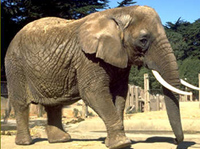
Your soul is free, at last.
Maybelle, the 10,000-pound African elephant, was conscious when zoo staff found her lying in her outdoor enclosure, but after administering pain medication, she passed away, zoo officials said.
She was born in Africa in May, 1960. Officials hope that a necropsy, performed Thursday, will determine the exact cause of death.
Maybelle's failing health had been compromised by orthopedic problems, a statement released by the zoo said.
In March 2004, the Zoo had to euthanize Calle, a 37-year-old female Asian elephant. Calle became the focus of a clash between animal activists and zoo officials.
Activists had been fighting to have Calle moved to The Elephant Sanctuary in Tennessee days before she was euthanized.
"Maybelle, Lulu and Tinkerbelle look sad and crippled. They barely move around at all at the Zoo-although it's no wonder as there isn't anywhere for them to go. It's time to move these elephants to a sanctuary where they will have hundreds of acres to move freely and be elephants-not just living museum pieces a part of a Zoo collection."
Welcome Elephant Friends
In Defense of Animals
Second Elephant at SF Zoo Dies in Less than Two Months
Date: 4/22/2004
From: alerts@idausa.org
To: Jody@JodysJungle.com
Second Elephant at SF Zoo Dies in Less Than Two Months
Animal Protection Groups Call for Immediate Closure of Elephants
Exhibits and Transfer of Two Surviving Elephants To Sanctuaries
San Francisco, CA
Another elephant has died at the San
Francisco Zoo, making her the second elephant in as many months
to perish at the facility, In Defense of Animals (IDA) announced
today. Maybelle, a 43-year-old African elephant, died within the
past day under circumstances that remain sketchy. On March 7,
the Zoo killed Calle, a 38-year-old Asian elephant, who had
suffered for years from debilitating ailments caused by decades
of captivity under grossly inadequate conditions.
IDA, which has been pressing for two years for the transfer of
the San Francisco Zoo's elephants to sanctuaries, reacted
strongly to the latest death, calling for an independent
investigation and permanent closure of the zoo's elephant
exhibits. IDA charged the zoo with "extreme negligence and
cruelty" for continuing to hold elephants in tiny enclosures
that prevent adequate exercise and socialization. These
conditions cause painful arthritis, foot abscesses, infections
and other health problems, as well as stereotypic behavior
indicative of emotional distress, from which all of the zoo's
elephants have suffered for years. (In the wild, elephants
travel up to 50 miles a day. San Francisco's elephants are held
in zoo lots of less than a 1/2 acre.)
'If the zoo had acted on offers to transfer the elephants to an
appropriate environment two years ago, the tragic deaths of
Calle and Maybelle could have been avoided," said Dr. Elliot
Katz, a veterinarian and founder of IDA. "Responsibility for
these deaths falls squarely on the shoulders of the zoo's
management, which has stubbornly insisted on keeping clearly
ailing elephants at the zoo under conditions which are literally
a death trap for world's largest land mammal."
Katz noted that Calle and Maybelle should have been in the prime
of their lives. (In the wild, elephants can breed into their
50's). He also said that while Calle arrived at the San
Francisco Zoo seven years ago, Maybelle, along with the zoo's
two surviving elephants - Lulu and Tinkerbelle - were captured
from the wild as babies specifically for the zoo and have spent
virtually their entire lives in San Francisco. As a result, the
health problems from which they suffer are directly attributable
to their time in captivity here.
IDA and Citizens for Cruelty-Free Entertainment are calling on
the Board of Board of Supervisors to immediately take action to
transfer the surviving elephants to one of two sanctuaries that
have offered to take the elephants at no cost to the City or
Zoo. The sanctuaries offer adequate space to allow freedom of
movement and access to a variety of natural substrates and live
vegetation, all of which is essential to healing the painful
joint and foot problems from which the elephants currently
suffer.
For information on how you can help, visit
In Defense of Animals
~
FAE Elephant Hospital Lampang
Update
4/18/2004
Dear Friends of the Asian Elephant,
For the past few months, FAE's Elephant Hospital has been full of in-patients, twenty six of them actually.
Eight have gone home, one who was less fortunate had to be euthanized on the 18th March.
It was Boondee who was attacked by the elephant in musth. She had complete fracture of her right hind leg (FIBULAR, CARPAL BONE, TIBIA). We found 2.2 KG Tumor in the vaginal canal.
The Five Residents:

Tanthong,73/ has soft diets of young bamboo leaves and horse pellets.
Tahnee, 28/ is still having anemia
E-Khe, 45/ is doing good.
Auan, 45/ had eye infection but is now recovered.
MOTALA,42/ is doing just fine. Her wounds are closing.
Landmine Victims:
Champen, Manguay-low and Mobra are getting better especially Champen. Her wounds have been healing fast and she could put her weight on the injured leg. Mobra had constipation the other day but she is alright now.
Mothers and babies:
JOKIA and BEE-BEE are just fine. BEE-BEE will be nine months old next Saturday.
THONGKWAOU and NOEL are also well. Thongkwaou has become a very possessive mother while Noel is a naughty baby.
We shall have a new pair of Mother and her young baby coming tomorrow. They are both suffering from malnutrition.
Another pregnant elephant will be coming with this pair.
Kaew and Kamsaen with foot rots had recovered.
Kampuan who is completely blind has returned home. She had burns on both hind legs, front leg, body and above the right eye (5 percent of her body) from the forest fire.
Boon-ngen, a 56-year-old bull has infection in both tusk cavities, four foot rots and abcess on his front left leg.
Kwaeng, 70/ is deteriorating.
Maekaew, 52/ got bitten on her tail so we had to amputate it.
Moreover, we treated 54 out-patients during Jan-March this year.
Protest Against Elephant Trade
FAE has sent another protest to the present Thai Premier against elephant trade.
More and more elephants have been traded outside Thailand. FAE's continued calling for ban on elephant roaming in cities and ban on elephant trade have resulted in several attempts to have me killed.
Elephants have been the victims far too long. It is true that some of them are still being traumatized and are traded by the selfish capitalists who want to sell them overseas for cash. FAE and I are against the authorities that allow these things to happen.
However, we have no legal rights to arrest these people but the government can.
Some people are trying to mislead the public, giving false information, etc. and it is truly unfair.
My sincere regards,
Soraida
Soraida Salwala
Founder & Secretary General
Friends of the Asian Elephant (FAE)
~
The Telegraph
Calcutta, India
Sukna, March 19, 2004
As the life of an elephant hit by a goods train here on Wednesday ebbed away, the outcry against the Northeast Frontier Railway reached a crescendo today.
The Calcutta chapter of WWF, the wildlife watchdog, is considering taking legal action against the railway that, it alleges, is flouting directives of Calcutta High Court aimed at protecting animals.
“The railway authorities are guilty of violating high court orders. We are consulting our lawyers and intend to initiate legal proceedings,” said S.R. Banerjee, the state director of the WWF.
~
2/10/04
Love Elephants?
Want To Help Them Live Free?
The Elephant Sanctuary (TES) in Hohenwald, Tennessee
launched has launched their
eBay auctions
You can bid, you can donate, you can help!
Bid High, Bid Often, For the Girls

~
From: Soraida Salwala
[FAE]
Little baby elephant at FAE's Elephant Hospital
Date: 3/14/2004
"BB & her mom, Jokia"
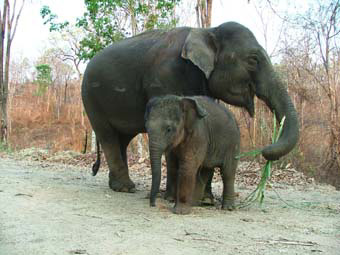
~
FAE's Report on Elephant Health Care
Bangkok/Wed 18 Feb 2004
Dear Friends:
Friends of the Asian Elephant [FAE] and myself would like to express our genuine thank you to all of our supporters who have been very kind to us. We could not have done what we have without your contribution, donation and supports.
I would, therefore, like to give you a summary of the work we have accomplished on the elephant health care.
Friends of the Asian Elephant's HOSPITAL [first on the earth] and our MOBILE Veterinary Project have reached their tenth year of continued work to improve elephants' health.
Since 1993 to December 2003, we have treated more than 1,588 cases.
(Part of the records of 1993 to 1997 were lost.)
IN-PATIENTS: 260
OUT-PATIENTS: 266
MOBILE VETERINARY PROJECT: 1,062
2003 REPORT: 276 cases which were divided into--->
IN-PATIENTS: 40
OUT-PATIENTS: 39
MOBILE VETERINARY PROJECT: 197
We do hope that their conditions would continue to improve.
FAE's website is under construction.
Please accept my apologies for any inconveniences during this time.
For the elephants,
Soraida Salwala
Founder & Secretary General
FRIENDS OF THE ASIAN ELEPHANT [FAE]
Registered Charity No. Kor-Tor 273
350 Moo 8, Ram-Indra Road Soi 61,
Tharaeng, Bangkhen,
BANGKOK 10230
Thailand
Tel & Fax: 66-(0)-2945-7124/6
e-mail: fae@loxinfo.co.th
website: elephant.tnet.co.th
~
New Calf Brings Hope to Sumatran Elephants
ID Nugroho, The Jakarta Post, Surabaya
February 12, 2004
Staff members of the Safari National Park II in Prigen, East Java are rejoicing in the birth of a male Sumatran elephant (Elephas Maximus) calf.
The calf was born at 9:45 a.m. on Monday to bull Subaru and cow Rahayu. He weighs 75 kilograms, and is 120 centimeters long and 90 centimeters tall.
While this was the fifth elephant calf to be born in the park since 1997, executive director Jansen Manansang said that the birth process amazed him.
Rahayu -- who was evacuated from the troubled Sampit area in Central Kalimantan a few years ago -- had a relatively smooth labor, which started with the first contractions at 4:30 a.m. on Monday. A team from the Safari National Park I in Cisarua, Bogor, monitored the birth process.
As the sun rose, the cow's waters broke and the calf was born ten minutes later, with his head and front legs first.
Source & Complete Story: thejakartapost.com
~
Performing Animal Welfare Society. CA
For two aging Asian elephants, this week was time for a change.
The two pachyderms — Minnie, 48, and Rebecca, 41 — were moved Monday to an animal rights organization's exotic wildlife refuge near San Andreas.
The 2,300-acre Ark 2000 refuge, off Pool Station Road, belongs to the Performing Animal Welfare Society (PAWS) Minnie and Rebecca joined two African elephants that already live there.
STORY
~
South India
January 8, 2004
Tortured Elephant Turns Boisterous
KOVILPATTI:
An elephant used for begging by its mahout, turned boisterous when the mahout started beating it, forcing the animal to beg on Tuesday.
It is a common sight to see elephants being pressed to beg in Kovilpatti and in Kalugumalai towns of Thoothukudi district. Three months ago, a mahout who was using an elephant to beg at Kovilpatti bus stand was warned by the police. However the practice continued unabated.
On Tuesday evening, when an elephant was taken around bus stand it refused to extend its trunk to receive coins. The mahout started hitting the animal with a cane when it became violent. The violent shaking of the elephant made it appeared as though it was about to run berserk.
People here fear that such treatment of elephants may turn them out of control and thus lead to attacking the people. Tirupathiraja, president of the Jan Kalyan has urged the government to prevent this practice.
indiavarta.com
~

CASEY
Sept. 24, 2003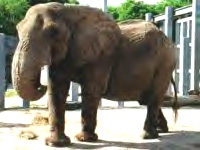
Casey, the elephant, a favorite at the Kansas City Zoo for nearly a half-century, was found dead early Wednesday in his outdoor enclosure.
After years of battles with infection and arthritis, Casey is presumed to have died of old age. A necropsy is planned.
The 52-year-old bull elephant was the oldest in North America and was believed to be the oldest in captivity in the world. At six or seven tons he also was considered the largest in North America.
"It's just like losing a loved one," said Kirk Suedmeyer, chief veterinarian at the zoo. "The staff has done a tremendous job over the years, in just the mechanics of caring for such a large animal. We were able to give him a quality of life, and we're very proud of that."
The Kansas City Star
The Kansas City Zoo's oldest elephant, Casey, died early Wednesday at the elephant compound.
Casey, 52, was the oldest resident at the zoo and also the oldest captive bull African elephant in North America. He came to the zoo in 1955.
Kirk Suedmeyer, the zoo's director of animal health, said that Casey lived past his expected captive lifespan.
KansasCityChannel
~
Premature Elephant Calf Euthanized
Sep. 23, 2003
FORT WORTH
All seemed to be going well with Rasha's much-ballyhooed pregnancy, virtually a repeat of five years ago when she gave birth to Bluebonnet.
But Rasha, a 30-year-old Asian elephant at the Fort Worth Zoo, went into labor Friday morning, 16 months into her pregnancy and six months before her due date.
Rasha's calf, which received round-the-clock care in a makeshift ICU this weekend, was euthanized Sunday evening by veterinarians who decided that she could not survive.
"As a group of veterinarians, we were confident in our medical decision," said Nancy Lung, the zoo's chief veterinarian. "For all the other reasons, it made it difficult to euthanize. It's easy to get attached very quickly."
The death of the calf, the second failed pregnancy of an Asian elephant at the zoo in the last 18 months, again highlighted the difficulties of breeding in captivity. Babe, one of the zoo's four adult cows, gave birth to a stillborn calf in March 2002.
No Asian elephants were born in 2002 or have been born this year at institutions accredited by the American Zoo and Aquarium Association, a birth rate so slow that it threatens the viability of the species in captivity, according to zoo experts.
Source and Story: startelegram
~
Elephant Killer Jailed
9/22/2003 - (SAPA)
Kampala
A Ugandan army officer has been sentenced to 18 month's imprisonment for masterminding the killing of seven elephants in Murchison Falls National Park in north western Uganda last July with the aim of stealing ivory, army officials confirmed on Monday.
The military spokesperson based in Gulu, Lieutenant Paddy Ankunda, said 2nd Lieutenant Emmy Kisembo who was based at the park at the time was also dismissed from the army by the division court martial sitting in the northern Ugandan town of Gulu last Friday.
"This was a deliberate effort to disrupt the tourism industry and the officer is automatically dismissed from the army with disgrace," Ankunda said.
Uganda Wildlife Authority UWA officials in Kampala were pleased with the verdict. "We found carcases of six adults and an infant and the adults had no ivory, which meant they were killed for ivory," UWA public relations manager Barbra Musoke said.
Source: news24.com
~
Sanctuary offers tourist treks to lure elephants off city streets
Surachai Piraksa
Dong Yai wildlife sanctuary in Buri Ram has started an elephant riding project in a bid to take the animals off Bangkok streets and back into the forest.
The project appeared successful as four elephants which previously roamed city streets had already returned to the forest. Rides could now be offered to tourists wanting to tour Don Yai wildlife sanctuary in Non Din Daeng district.
The sanctuary, of more than 200,000 rai, is rich in fauna and flora, boasting rare animals such as Bos gaurs, banteng, species of wild cattle and wild birds.
Sanctuary chief Sutthichart Ra-biap said elephant owners in Satuk district had brought four animals to join the project.
Many elephants were being forced to roam city streets, helping their handlers beg for food and money.
Mr Sutthichart said his agency also trained elephants to help patrol forests. This was being done in Lampang where 99 elephants, which used to be on city streets, were distributed among 37 national parks and wildlife sanctuaries.
Their mahouts had been hired at 15,000 baht a month to assist in patrols and take tourists on treks.
~

Elephant Musth/Boon Kuhm
A new kinder way to treat bull elephants and ease their suffering.
by Sangduen Chailert (Lek) - 17 September 2003
Click here to read about Boonkhum and see his newest pictures, what a change!

~
Stupid Human Tricks
Elephant Crushes Man to Save Her Calf
Sunday September 14, 2003
KOLKATA:
An elephant that was guarding her newborn calf from a hostile crowd crushed a man to death in a village in West Bengal in eastern India.
The elephant, which gave birth on the edge of a village in the jungles of Goaldanga in Bankura district Friday, was joined in her vigil by two male elephants, as she waited for the calf to stand on its legs.
The vigil lasted two days, during which the villagers of Goaldanga got wind of it and soon a crowd of about 1,500 people gathered around, local newspapers reported.
The unfriendly crowd beat drums and burst firecrackers around the elephants and also threw stones.
When the crowd advanced towards the baby elephant, its mother charged at the crowd and lifting an old man in its trunk, crushed him under its massive feet.
The furious animal then kicked around the dead man, identified as 70-year-old Fatik Mondal, as forest guards stood around helplessly.
Wild elephants have killed 252 people in the state in the last five years, and 122 of the animals have also died, many allegedly poisoned by villagers.
Villages in the southern districts of Midnapore (west), Purulia and Bankura are acutely plagued by the elephants, which emerge from the Dalma forest in search of food and destroy ripe paddy crops, besides trampling huts.
Villagers chase them away with flaming torches, the noise of crackers and beating of drums. However, the elephants seem to be losing their fear of such objects, say wildlife experts.
Newindpress, India
~
~
Flash Floods Threaten Elephants
Elephant Nature Park Finds a New Home
From:elephantnaturepark@thaifocus.com
To: Jody@JodysJungle.com
5/5/2003
Hi Jody,
We are delighted to announce that Elephant Nature Park has re-located to a
new, larger home. A beautiful valley with a river running through it, the
area in Mae Taeng, Northern Thailand is a perfect natural
place for the ever-growing herd and .. with well over 100 acres there is
plenty of space for them to move around. View pictures and story at the following
URL
Thanks for your efforts,
Adam
Elephant Nature Park
209/2 Sridornchai Road
Chiang Mai 50100
Thailand
Tel 053 818754, 818932 Fax +66(0)53 818755
info@thaifocus.com
~
LOTA
April 20, 2003
Source: The Elephant Sanctuary in Hohenwald, Tennessee
SAVE 53 -YEAR -OLD ELEPHANT IN EMERGENCY CONDITION
The Council for the Retirement of LOTA has written a petition to ask for the public's support in an urgent matter concerning the desperate plight of a 53 year old elephant named Lota.
In 1990 the Milwaukee Zoo was forced to release its elephants after overwhelming evidence of the zoo's egregious elephant abuse was exposed to the public. All of the zoo's elephants were retired to sanctuaries, except LOTA.
Lota was prevented from being retired. "Despite a public outcry, the Milwaukee Zoo DONATED Lota to the Hawthorn Corporation. The 1990 publicized transport depicted 40-year-old Lota being beaten onto a trailer, falling and urinating blood." The U.S. Department of Agriculture (USDA) remained silent.
Although chronically ill, Hawthorn leased Lota to circuses. Like all circus animals, Lota traveled year round in unheated boxcars, deprived of water, food and ventilation - perpetually in chains and shackles. As a result of her deplorable life and living conditions, Lota contracted a human strain of tuberculosis and became severely emaciated.
Hawthorn Corporation is located in Richmond, Illinois. Hawthorn trains and leases elephant acts to circuses and facilities worldwide. For over a decade, the USDA has cited Hawthorn for failure to meet minimal federal standards for the care of animals used in exhibition as defined in the Animal Welfare Act (AWA). Hawthorn's litany of violations frequently relate to its gross "failure to provide veterinary care" and "physical abuse of elephants."
Hawthorn is continuously cited by the USDA and has accumulated $72,500 in USDA penalties. The USDA has twice suspended Hawthorn's license. Hawthorn has repeatedly failed to comply with prescribed tuberculosis treatment protocol.. As a result, four Hawthorn elephants have died from a human strain of tuberculosis. Despite decades of flagrant animal cruelty and negligence, the USDA has made no attempt to revoke Hawthorn's license.
LOTA IS NOW 53 YEARS OF AGE.
She has been enslaved for her entire life. In June 2001, Lota traveled with Walker Bros. Circus. USDA documents state that Hawthorn was cited for "failure to provide veterinary care to Lota who was excessively thin, with a protruding spine and hip bones and sunken in eyes." The inspector wrote, "It appears that Lota has lost a significant amount of weight."
The rest of Lota's story
Hawthorn continues to demonstrate an arrogant defiance of USDA directives and federal law. Nevertheless, the USDA has not revoked Hawthorn's license. This long history of USDA inaction is disgraceful and untenable.
John Cuneo, CEO of the Hawthorn Corporation, has rejected all offers to retire Lota to a sanctuary. In view of this, we wrote to ELLEN MOYER, THE MAYOR OF ANNAPOLIS, MARYLAND, asking for her assistance. Mayor Moyer wrote to Cuneo requesting the humane retirement of Lota. Several sanctuaries are willing to provide a permanent home for Lota.
We ask that you join Mayor Moyer in demanding the immediate and permanent retirement of Lota and the permanent revocation of Hawthorn's license.
Lota is worthless to Cuneo from a monetary and performance standpoint. MOREOVER, LOTA WAS DONATED TO CUNEO. By publicizing Lota's plight, we believe that Cuneo will realize that it is in his favor to release Lota. The strength of Mayor Moyer's request has started the momentum and we believe that Cuneo will release Lota based on a successful petition campaign.
If Lota is not currently traveling, she is warehoused in Hawthorn's compound in Richmond, Illinois. The facility has been cited by the USDA. IF LOTA IS NOT RETIRED IMMEDIATELY, SHE WILL CERTAINLY DIE. It would certainly be in Cuneo's favor to retire Lota - rather than for her to die at Hawthorn. Lota's death would create additionally bad publicity for Cuneo.
With proper medical care and a natural environment, Lota can still enjoy freedom (albeit man-made), companions and the security of a permanent home - all of which she has been denied.
Please help secure this majestic individual's long overdue retirement by signing our :
PETITION
What else we can do:
After signing the petition, Contact John Cuneo.
Ask that he retire Lota now.
John Cuneo
23675 W. Chardon Road
Grayslake, IL 60030
Tel: 847 546-0717
Fax: 847 546-3354
Contact the U.S. Secretary of Agriculture and urge her to seize Lota now and immediately retire her to a sanctuary.
Urge Secretary Veneman to permanently revoke Hawthorn's license. Your taxpayer dollars support the USDA.
The Honorable Ann M. Veneman, Secretary
U.S. Department of Agriculture
1400 Independence Avenue, S.W.
Washington, DC 20250
Tel: 202 720-3631
Fax: 202 720-2166
Email: agsec@usda.gov
Lota The Elephant Sanctuary
Lota Elephants@JodysJungle.com
~
Udawalawe Elephant Transit Home
Sri Lanka
Elephants and Born Free
Born Free believes that wildlife belongs in the wild, and the ETH (Udawalawe Elephant Transit Home) is the only facility on Sri Lanka that is designed to return orphans to their natural home. The elephants living there are not exploited for tourism or for domestic uses - they are simply treated as well as the facilities allow until they are ready for release. This combination of welfare and conservation, maintaining the dignity of these beautiful animals, is what makes the ETH stand out as a prime candidate for Born Free's support.
~
Slaves No More!
On behalf of the Thai elephant, we seek liberty from the chains of
suffering caused to the Asian elephant; to end the cruelty, abuse and
lack of protection; to stop their decline to extinction; and to answer
their cries for freedom.
Do you know that March 13th is Elephant's Day in Thailand.?
What can you do to ensure that such days are no longer necessary, when
the elephant is finally free from the persecutions which they face?
Domesticated elephants have no daily life of their own - whatever their
employment. They are bound by the whims of their employer, walking
within the iron bars of their employer's prison. No way out. Bound in
chains and forced to labour, often beyond their mental and physical
capabilities. Sometimes they are abused, worked to the point of collapse
with no respect for their most basic requirements. Surely they should
have the right to share this planet in harmony with us and other
creatures.
Does the domesticated elephant have the right to be free? To have the
right of protection; to have the right to be free to live without the
daily fear of facing their overwhelming problems which they are helpless
to control. How can we prevent the accelerating decline in elephant
numbers? Today is not just a day for labels; it is a day for action, for
us to take on the responsibility to ensure their survival.
Only you are the ones who hold the key to open the door to their
liberty.
If you think the Thai elephant needs support please write to:
Dr Taksin Shinawatra
Prime Minister of Thailand
Government House
Bangkok
10100
Thailand
e-mail : rakang@thaigov.go.th
Best Regards
Lek (Ms Sangduen Chailert)
Elephant Nature Park - Founder
Office: 29 Charoenpratet Road, Soi 6
Chiang Mai, Thailand
Tel: +66(0)53 272855 Fax +66(0)53 271680
email: lek@thaifocus.com
URL: Thaifocus.com
~
Boon Khum Update 3/10/2003
Dear Jody,
Thanks for e-mail and your love always to animals. Boonkhum is stay with me very closely this time. I have the picture which I took of him , he has heals and put on more weight. Also his mentality is much better, he allow me to go under him to clean and check his skin around stomach . He show and paid love back to us. The first time when Boonkhum arrive he was very paranoid . Now he plays with the other elephants. I never see Boonkhum have so much joy time like this time. I will try to send the picture to you. So about Boonkhum, I'm happy to tell you that he is in excellent condition and it so amazing to see him healing.
Thank you once again for your love and care to the gentle Giants.
Talk to you soon.
Love, Lek
Elephant Nature Park - Founder
Office: 29 Charoenpratet Road, Soi 6
Chiang Mai, Thailand
Thaifocus.com
The Magnificent Boon Khum

Ivory poachers drugged and chained Boon Khum to a tree last year and took off his tusks with a chainsaw. (It's like cutting someone's tooth off at the gums—hits all the nerves.)
When poachers sawed off the tusks, they cut too close to the nerves in his face, the pain and infection where the tusk was cut was tremendous; it spread throughout the elephant's entire face, nearly killing him.
A terrible infection developed. The sicker he got, the more aggressive he became. When Lek Chailert found him a few months later, she called him a "skeleton walking".
That's when she bought him, to heal him.
Mahouts clean out his tusk cavity daily using traditional Thai medicine; herbs are collected in the jungle, chopped up, and boiled in river water. Water guns shoot the medicine into Boon Khum's hollow, infected tusk cavity. It's unbelievable to watch this massive beast stand patiently for at least fifteen minutes every day, while this procedure occurs over and over.
ELEPHANT BABY NAMED
~
BIRTH ANNOUNCEMENT
Dear Jody,
Ging Mai
On Friday night (22 Nov) Ging Mai was healthy, happy and full of the natural curiosity of an inquisitive infant.
The following day he became weak and unable to stand. Despite round the clock supervision his condition grew steadily worse until his final passing in the early hours of Sunday.
Ging Mai (Little Tree) & Yod Doi (Hope) March 2002
When the rescue team arrived, they went straight to work, treating and caring for the injured elephant. Even in the harsh shadows of night they saw the grief and pain of this sick baby. Lamenting the loss of his mother the terrified infant cried and sobbed constantly. His mother had died the previous night...
Update Ging Mai
Ging Mai Settling In
Christmas day. Ging Mai's first steps outside his pen since his rescue. He is hesitant
as he explores the unfamiliar surroundings. Slowly and cautiously he leaves the safe
confines of his home, stopping first to play with some water bottles. It takes a while for him
to gain confidence and he keeps close to obstacles such as tents. He initially avoids open
spaces. All elephants have an acute sense of smell and Ging Mai is no exception. He sniffs
the volunteers tents and sarongs belonging to Lek which are drying in the sun. Recognizing
the scents of those close to him bring comfort in unfamiliar surroundings.
Slowly he begins to feel more positive but stays within close range of his helpers. Always
smelling his way around the open spaces are now a huge adventure for the youngster.
Lek is delighted with his progress and feels that this exercise will help him recover more
quickly. She expects that it will take months before his physical and mental scars will heal.
When he is strong enough he will be brought to a surrogate elephant mother who hopefully
will take him on as her own. At this stage he will be able to digest solid foods.
He now begins to tire and slowly ambles back to his pen. Leks brother in law, Daeng, has
made a bamboo gate for easy access. Ging Mai will be walking every day, gaining strength
as he explores the new world of an infant. He suckles the milk bottle, consuming over 25
litres a day, as his eyes begin to close. He's had a busy day!
The miracle continues and further progress reports will follow'
GING MAI December 2001
~
UPDATE: CBCB Elephant "Bessie" Retired
~
"She was found in a swamp near the all but gone Imenti Forest, all
alone, on the morning of 18th September 2002, the rest of the herd
having fled, no doubt due to human disturbance. We have named her "Wendi", which in the Meru tribal dialect means "Hope" and
we have named her thus, hoping that CITES makes the decision to
hold the ban on the sale of Ivory, which will bring "hope" for the
survival of elephants, "hope" that the Imenti elephants will one day
have a safe corridor to the forests..."
~
~
New Problems for Asian Elephant Conservation Fund
~
LOKI
Update on Loki Report on the Makhna Elephant LOKI
Report on the Makhna Elephant LOKI
Update on LOKI
Photograph by Jennifer Hile
Source: 2002 National Geographic Society
There is also a video of the baby,
the quality isn't the best but it's worth watching to see the baby and her mom interacting.
Name The Baby Elephant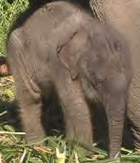
The Elephant Nature Park is proud to announce the birth of a female elephant, Born Jan. 25, 2003 at 3 PM.
The infant girl's father is 20 year old Pookie, her mother is 16 year old Sao Yai,
both parents are ex logging elephants.
"We are also taking advice from our site visitors as to the name of this
youngster so get thinking. Entries can be in any language and the final
date is Feb. 14, 2003. We wish to reflect on the feeling of "freedom" when naming this youngster AND the word doesn't necessarily have to be in English!"
All the best,
Adam
Elephant Nature Park
209/2 Sridornchai Road
Chiang Mai 50100
Thailand
![]()
A Tragic End
Elephant Nature Park
November 2002
Goodbye Little One, your mother is waiting.
Ging Mai's Story

Elephant Nature Park
Update, April 2002
"Ging Mai (Little Tree) has been the centre of attention since his arrival late last year. His wounds have closed and he is in good health. Soon we hope he will be strong enough to join the herd under the protection of an ever watchful mother."
"Hope (Yod Doi) is over nine months old, both infants share similar backgrounds in that they have had to pull through the toughest of times without the loving care of their mothers."
Pictures
Ging Mai ~ (Little Tree)
The Healing Time
Update March 2002
Lek and the volunteers have made a big mud bath for Ging Mai, and put a children's wading pool next to that. (Lek has promised to have the pictures uploaded in a few weeks, meanwhile, she is off, trekking through the jungle again.) Ging Mai's main daytime activity is playing in the mud bath, running to the pool and rolling in the sand . He has also started to walk though the jungle and around the surrounding hills. He has conquered his fear of trees. He now has a new friend, Yod Doi...
Yod Doi ~ (Hope)
Another successful infant rescue.
2/5/02
Dear Jody,
"Just want to let you know that little Ging Mai start to go to swimming today. He was very exciting to see the swimming pool. We bought the baby swimming pool for him. We will put the picture in the web-site soon."
Lek
Update Ging Mai
1/17/02
Ging Mai is putting on weight, his wounds are beginning to heal, he leaves the pen with keepers to walk and exercise.
In the next two months, he will meet his adoptive elephant mother.
For now, he believes his mother is Lek (Elephant Nature Park - Founder)
"Jody,
Every time when he see me he will coming to use he trunk to hug me and then ask for milk. some time if I not around him he will trumpetting very loud, and then when he see me he will stop and walk to put his head close to my legs as the same most of the baby elephant did with their mother. I start to worry for the next few month when he ready to release with his adopt mother. I wonder that he will accept the new life or not."
Lek
(I think Ging Mai will recover from his wounds, but probably not from the trauma of losing his mother. I'm thankful he has been found by Lek, he couldn't have a better foster mom.)
JodysJungle was honored to have been able to underwrite milk for little Ging Mai.
25 December 2001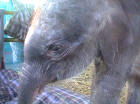
Ging Mai Videos
Copyright © 1997-2001
(I actually didn't realize how severe Ging Mai's wounds were until I saw the video.."First Steps"..I'm still not sure he will survive, he is so very young and susceptible to infection.)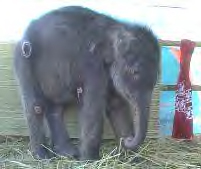
Loses his mother but gains a home.
This courageous infant survives against impossible odds.
The first three days of this new born male calf were as dramatic as they were terrifying...
Full story @ Thai Focus
11/18/02
After repeated complaints from concerned humane people, a statement from
a prominent elephant vet, and threatened AWA lawsuit, the Clyde Beatty -
Cole Brothers Circus has Retired elephant Bessie to the Wild Adventures
Theme Park in Valdosta, Georgia. Bessie had a injured front left leg and
was being forced to work. While an elephant sanctuary would have been
preferred, the park has a large grass and tree field she can now roam with other elephants. Since 1997 four elephants were forced to
work and retired only after they could hardly stand. They died weeks
later.
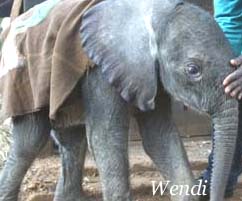
The Sheldrick Wildlife Trust
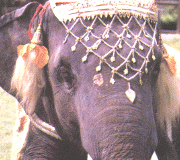
Source: Mahidol University Thailand
May 2002
By Dr. Michael W. Fox
Hon. Chief Veterinary Consultant
India Project for Animals and Nature
The US Fish and Wildlife Service administers the multimillion-dollar Asian Elephant Conservation Fund, paid for by US tax-payers. One anti-poaching project funded in the Nilgiris, S. India, needs immediate review. Tamil Nadu State Forest Department forest watchers and guards have complained to India Project for Animals and Nature (IPAN) that the anti-poaching training course that they are currently enrolled in at the Theppakadu Elephant Camp in the Mudamalai Wildlife Sanctuary is a joke. The course has been reduced from 15 to 10 days. They are given lectures on elephant reproduction, diet and longevity, but no jeeps, radios and other essential anti-poaching equipment and training are provided.
A few months ago a group of trainees contacted IPAN for help after being left stranded in the jungle at night without transportation, flashlights, food or water.
IPAN estimates that close to 60 wild elephants have been killed in the region over the past 18
months...
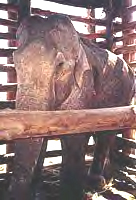
June, 2003
Loki is lost to the system, deep in the jungle at a government camp.
at the Theppakadu Elephant Camp
Mudumalai, India, from February 3rd - 6th 2002
for India Project for Animals and Nature
Alan Roocroft, Elephant Care Specialist
with the San Diego Zoo for the San Diego Zoological Society
Housed at the Mudumalai Elephant Camp:
Physical Condition, Treatment, and Prognosis
January 6th - 27th, 2002.
By James Mahoney, D.V.M., Ph.D.
President
Sanctuary Support Program
Monroe, New York
March 11, 2002
LOKI Page @ IPAN
LOKI 2002
While searching for updates on Motala, I ran into some information about an elephant named Loki who's story is
so horrible I refuse to put it on this page until I find an update, that he has either been saved or killed.
After much searching, this is all I could come up with on Loki... Loki was moved deep into the interior on government
land so that outsiders could not find him. The last reports coming from there are that he is no longer being abused
because he is now totally subdued and still a prisoner but working for his captors and adjusting.
A Mahkna* Elephant
*Tuskless
~
Liquor-Loving Elephants Wean Villagers Off The Hard Stuff
Illicit liquor manufacturers in eastern India complain they are being put out of business by rogue elephants with a fondness for booze.
Elephants in West Bengal's Midnapore district have gone on the rampage destroying thousands of barrels of alcohol.
The owners say the animals are attracted by the smell of liquor being produced at the distilleries.
They have now appealed to the police for protection against wild elephants, reports the Pragati newspaper.
Biman Mahato, a businessman whose liquor outlet was damaged, said: "The fact that the elephants love the liquor produced by us could have been a great advertisement for our business if only there was something left for us to sell."
The paper says villagers are now attending literacy classes instead of frequenting liquor dens in the evenings.
Farmer Anadi Sahu said: "The elephants deserve all the credit for weaning us away from drink. We now think of growing crops and educating ourselves."
A police spokesman said: "The so-called elephant menace is a blessing in disguise. They have been able to achieve what we could not in so many years."
Source: Ananova
26th March 2002
~
Update:The community fought hard but the director wanted Savanna to stay so once again they got an elephant from Ringling Brothers Circus and convinced the community that both elephants would be happy.
SAVANNAH
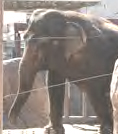
Savannah, an elephant at the El Paso Zoo, is now alone after the death
of her long-time companion Mona.
Please contact the
mayor and City Council of El Paso and ask that they allow Savannah to
retire to the Elephant Sanctuary, where she can roam several hundred
acres, swim in the spring-fed ponds, roll in the many mud pits, and
thrive in the company of the other retired elephants, including
SISSY, her old friend from El Paso who retired there two years ago.
Savannah is nearly 50 years old and has served the public long enough
... it is time for her to retire.
Please e-mail and/or send a polite
letter immediately.
~
BABE

Babe is a 13-year old elephant whose mother was killed in a culling in Africa. Babe was crated and sent to the U.S., and performed in a circus for 10 years until she came to the
BLACK BEAUTY RANCH (@ The Fund For Animals.)
When she arrived a few years ago, she was skinny, and had dry skin, an injury above her ear from another elephant’s tusk, and two legs in poor shape. Her right front ankle had been broken and is frozen, and her back leg was badly injured as a result, we believe, of her having been hit by a larger elephant while chained.
Recently, she began having problems with her back leg and started lying down to avoid the pain of standing on it. Chris Byrne, the ranch manager, decided that the time had come to have Babe’s problem reevaluated and a course of action determined. He marshaled all his resources, and arranged an evaluation for Babe at Texas A&M.
Read Babe's Story
~~~
"Dear Jody,
I am happy to report to you that Babe is just fine and is in a good & happy mood all the time. She is particularily fond of one of the employees here and you can hear her happy sounds when he goes down the road beside the Elephant yard. She especially likes her daily baths. Our weather is good and she loves being outside. Her foot has improved and The Doctors decided against the boot.
Sincerely, Loree"
~
BALARAMA
(The one that got away..for a while)
"In a shocking incident for the past few days Dasara elephant Balarama, who has been trained to carry the golden howdah on Vijayadashmi day for the Dasara celebrations, was missing from Kallalla range in Nagarahole forest. There was a big hue and cry.
Over 60 forest guards and 70 tribals took part in the massive search operation to locate Balarama. The 43-year-old Balarama had escaped into the Nagarahole forest area after developing 'masth'."
~
Jokia's Journey

Jokia is a female blind elephant from a remote province in Northern Thailand. Jokia was blinded by chronic abuse. While working in an illegal logging operation, slingshots were aimed at her eyes if she didn't follow orders. She went blind in one eye. Later, the owner sprinkled gun powder in the other eye, so now she is completely blind.
Freed from commercial exploitation, Jokia heads for The Elephant Nature Park, an eight hour journey, to spend the rest of her days in the company of the herd. Jokia now is enjoying her new life of freedom, with a mahout to check on her every few hours. She is not chained, and is making friends with other elephants in the forest.
Jokia's final road journey to the park is featured here.
Source: Thai Focus
info@thaifocus.com
~
MARY & ELLEN

Ellen, a lovely, lonely lady in her fifties, who has lived alone for the past 20 years in the Little Rock Zoo. (People in Little Rock call it a zoo, though the American Zoo and Aquarium Association refuses to do so.) Her living space is small, she doesn't do much except stare at the ground...the people of the town love her so much they want to keep her...I wish they loved her enough to send her to The Elephant Sanctuary in Hohenwald, Tennessee. But instead, they acquired a new elephant, MARY. Now there are two sharing a space not big enough for one.
~
JOYCE

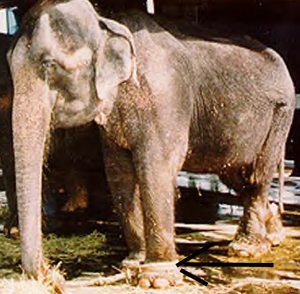
(Photo
Courtesy of The Elephant Alliance)
Joyce, a pathetic victim of CIRCUS VARGAS,
was forced to continue working despite the fact that for years she was dying of Tuberculosis.
"After months of sickness, JOYCE collapsed and died. Three days later, HATTIE collapsed as she was being unloaded from a
truck. Instead of calling a vet, CIRCUS VARGAS officials simply pushed her into a trailer, and she died all alone while being
shipped back to winter quarters in Gray's Lake, Ill. Tests showed that both elephants had died of TB. Both Joyce and Hattie had
given rides to children up until the day before their deaths."
The Story of JOYCE & HATTIE
~
TIA

In "I Loved Rogues", elephant trainers George Lewis and Byron Fish wrote, "All well-trained performing elephants are well-scarred elephants." TIA, an 8-year-old African elephant, was about to find out what those words meant. A roadside attraction in Iowa wanted an elephant to give rides and entertain the public. In May 1991, Tia was purchased and sent to an elephant training facility in Wisconsin. Upon arrival, she was led inside a barn and shackled by four legs. Restrained and unable to flee, she was beaten viciously with baseball bats and ax handles. Her trainers, not satisfied with the stinging pain inflicted by standard electric prods, invented their own version of electrical shock training. They wrapped an electrical cord around an ax handle. Exposed wires at one end of the cord were fastened to two screws embedded in the handle. The other end was plugged into an electrical outlet. Each time the metal screws were pressed against her delicate skin, Tia was jolted with a 110-volt electrical current. Confused and terrified, she would suffer even more injuries every time she struggled to escape or attempted to defend herself. She remained there for four months. When the chains were finally removed, she could hardly walk. Tia’s physical and psychological abuse left her dispirited and covered with cuts, open wounds, and scars. In December 1992, Tia was sent to another dilapidated amusement center in Virginia where elephants were left in the hot sun with no shade and water or chained inside a building with feces-smeared walls and urine-soaked floors. Far short of her 70-year life expectancy, she died there in January 1996.
~
Dumbo's End
By Andrian Kreye©
"In fifty years the elephants in Thailand will be extinct."
The guests at the Elephant Hospital in Lampang tend to be difficult patients. BATANG suffers from depression, insomnia
and a nervous twitch. UMPAH can't be alone, even for five minutes, or else she bursts out crying. Neuroses, nervous ticks, and anxieties, these are "the ills of society"--says doctor Pricha Pungkham, director of the Elephant Hospital.
"Nobody wants to understand that elephants suffer as much under modern development as human beings. And with the same results: unemployment, poverty, homelessness, drug-addiction." The doctor's sorrowful eyes stare into space.
All too often he has given the
same speech.
~
There's A Skeleton In A Trainyard In East Tennessee
By Joan Vannorsdall Schroeder
It was 1916, and things were changing fast. World War I raged in Europe. Dadaism, ripe with comic derision
and irrationality, took hold in artistic circles. Freeform jazz took hold of the American music scene. Margaret Sanger
opened the first birth-control clinic. It was a good year for scapegoats. It was a good year to hang an elephant.
~
Asian Elephant Habitat Program

The north-western elephant range in the state of Uttar Pradesh stretches along the Shilvaliks and runs into the outer Himalayas, covering an area of about 5000 square km. An estimated 800-1000 elephants live in this Elephant Reserve (also called the Elephant Reserve No. 11) and this range is divided into three major sub-populations with only bulls crossing the narrow corridors between these sub-populations.

The Rajaji-Corbett National Parks are probably the most beautiful elephant habitats in India.
Please click here to learn more about the First Phase
of the Elephant Habitat Program.
Donate to the
Asian Elephant Habitat Program
~
BARBARA
The Elephant Sanctuary Mourns

Please click on the picture to learn about Barbara, pay your last respects, meet her family.
~
The Elephants of Corbett
Are Under Attack
In February-April 2001, a sudden outburst of illegal elephant poaching activity was reported in and around Corbett
National Park. Located in the state of Uttaranchal, India, Corbett National Park is a showcase for tigers and elephants,
and the location of the Elephant Sanctuary's Asian Elephant Habitat Program.
~
~
From The Elephant Sanctuary in Hohenwald, Tennessee
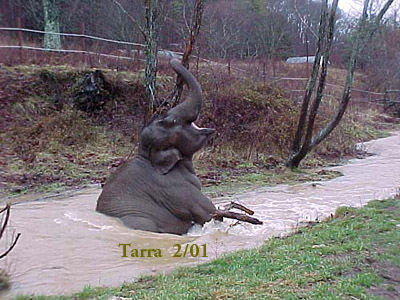
TARRA
Playing in the Creek After the Big Rains of February, 2001
I swear the girl is laughing!
More Pictures - More Elephants - More Sanctuary
~
SISSY
Sissy's story upset me so much that I started an auction site on eBay
In the record flood of 1981, Sissy and many of the Frank Buck Zoo's animal collection were swept from their
enclosures. Sissy was presumed dead but when the waters started to recede, she was spotted. Actually it was her
trunk that was spotted, wrapped around a tree limb, sticking just above the water line. It would be another 24 hours
before the water level dropped enough for Sissy to free herself from the tree that her body and trunk were wrapped
around. Sissy suffered long-term emotional trauma from that horrifying accident. Several who were close to her have
said that the threat of a pending storm causes Sissy to become petrified with fear. Her phobia of water was so deep
that for years Sissy would allow only one keeper to give her a bath.
A former longtime resident of Gainesville's Frank Buck Zoo, Sissy a 36-year-old Asian elephant, has been videotaped
being savagely beaten by workers at her new home in the El Paso Zoo. The tape shows zoo handlers hitting the
chained elephant repeatedly on the back of her legs with wooden bats and/or ax handles during a violent beating
session that lasted several hours. If the elephant did not respond to a given command within a few seconds, the beating
begans again. Twice she was hit so hard her legs buckled and she fell to the ground.
Upon notice that the City of El Paso wished to send Sissy to the Elephant Sanctuary, Carol Buckley, founder and
executive director of the Sanctuary, went to El Paso to meet this notorious elephant. What she found was a severely
underweight, depressed animal. Zoo staff reported that Sissy was not yet accepted by the other elephants and that
Savanna, one of the two other elephants, had knocked her down at least twice. Each time a crane had to be brought
into the yard to get Sissy to her feet. Sissy was not lying down at night and had difficulty rising when she did lie down.
Earlier this year the elephant staff spent four months hand-feeding Sissy after a medical procedure left her trunk
completely paralyzed. Thanks to their dedication, Sissy was able to consume enough calories to sustain herself, but she
still remains quite thin. Her keepers say Sissy is well behaved and attentive to their requests. They say she has shown
no signs of aggression since the initial "discipline session." Several factors were considered when the staff of The
Elephant Sanctuary decided to accept Sissy: her physical condition, her emotional condition, her behavioral history, and
her current status with the other elephants. Sissy will arrive at her new and permanent home at The Elephant
Sanctuary weather permitting, this month, January 2000.
Once again, may I say, with blurred vision, Bless These People.
March 1, 2000
When I first read about this girl, I was heartbroken and couldn't wait for Carol and Scott to bring her to the Sanctuary...I couldn't wait until she actually arrived, I couldn't wait until the day she would leave the barn. I pestered the Sanctuary by email continuously.."When will Sissy be allowed to come home? How many hours will it take? Where is Sissy now? Is she alright in that trailor? When will she leave the barn? Are the other girls accepting her? Did she sleep last night? Did I just see Tarra eat Sissy's food?" I'm so glad that we both have settled in....
The Elephant Sanctuary
January 26, 2000 noon
Arrived At The Sanctuary!
and gave half of everything I earned to The Elephant Sanctuary, I HAD to help Sissy get to The Sanctuary, I just HAD to! And I did. It can be done.
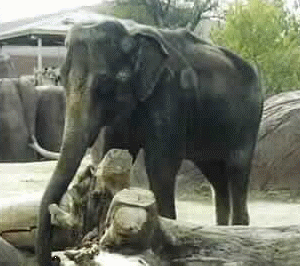
And bless you Sissy, I'm looking forward to watching you settle in to your new life and home.
Sissy has changed quite a bit since her arrival at the Sanctuary. She has become accustomed to the barn and the
other elephants, and has a new dog friend. She just recently ventured out of the barn to spend hours doing something
she has never done before, which is to be outside, on natural ground, with no chain, grazing fresh new spring
sprouts.
I wish I could have been inside of her mind during those moments.
Bless you, Sissy.

I cannot begin to express the depth of my emotion, when I see this picture
of Sissy actually playing in the Pond.
Thank You, Carol, Thank You, Scott...I'm so grateful for your existance....
~SISSY UPDATE~
September 1, 2001
Not only is Sissy happy at her home in Tennessee, some of her suffering, the terrible beating she received, may change the lives of other captive animals.
~SISSY'S LEGACY~
Sissy's Treatment Prompts Change in Attitude at EL PASO ZOO
~
MOTALA
MOTALA Update: 2003
~
PHANG KALOO and PLAI BOONRAWD
Motala, the female elephant who lost a foot after stepping on a land mine in Burma, near the Thai
border, is not alone. Two more elephants have now suffered the same fate. Plai Boonrawd, a two year
old baby received serious injuries to its legs and eyes when it trod on a land mine recently and last
week, Phang Kaloo an adult female elephant, stepped on a land mine while foraging for food in a
Burmese forest. Phang Kaloo received similar injuries to those of Motala and its condition worsened
as a result of a three day trek to evacuate her to safety. Phang Kaloo was initially taken to the Lampang
elephant hospital where Motala is recovering slowly but vets there decided to move her to Nakhon
Pathom animal hospital which is supposedly better equipped to deal with the injuries. Meanwhile, the
two year old is reportedly making good progress and is eating well.
~
DAMINI
BBC Thursday, May 6, 1999 World: South Asia
~
Sharing the World with Feeling Creatures
~
KENNY
KENNY was born at Ringling’s "conservation" facility on August 19, 1994. Like all baby elephants born at Ringling, Kenny’s real mother was soon replaced with a surrogate—the bullhook-wielding trainer..(Mark Oliver Gebel of Ringling Bros. and Barnum & Bailey Circus, accused of gouging the hide of Asia the elephant as she was being led into the ring of San Jose's Compaq Arena 2001.)
At barely 2 years of age, Kenny, an endangered Asian elephant, was relegated to the status of a clumsy clown as he was shipped around the country in a rail-car and made to perform silly tricks.
On January 24, 1998, Kenny was clearly very sick when the circus was performing in Jacksonville, Florida. The trauma of being taken from his mother and the rigors of travel likely stressed his delicate immune system. Kenny was nevertheless forced to suffer through two last performances at the insistence of Mark Oliver Gebel. Little Kenny died that evening, alone in his stall and without veterinary care.
~
SADIE
Sadie was a young, timid elephant. Her trainers believed it was essential that elephants used in circuses learn fear of punishment and discomfort as basic discipline. They were impatient and she was confused by the strange, puzzling tricks that were unnatural to any elephant.
One day, Sadie attempted to run out of the ring. Her trainers brought her back and began to punish her for being "stupid." Overwhelmed with a sense of frustration, helplessness, and hopelessness, Sadie laid down and began to cry. Tears streamed down her face as her huge body heaved with every desperate sob. Her spirit broken, Sadie would never regain the freedom and dignity the circus had so cruelly taken from her.
Circuses.com
~
Mickey Mickey was just 15 months old, a nursing baby, when he was taken from his mother, prodded into an arena and forced to perform confusing tricks for the King Royal Circus. Disoriented and frightened, Mickey couldn’t follow the trainer’s orders–so he was punished. During a performance in Oregon, as horrified circusgoers watched, Mickey was savagely beaten with a bullhook. The little elephant collapsed, screaming. Terrified and bleeding from his wounds, Mickey tried to crawl away, to escape the painful blows. But for captive elephants, there is no escape.
~
Let Us Entertain You
A Life In Chains
~
A Burden on the System ~
INSPIRATION
The Elephant Sanctuary
Story with Pictures..2002/2004
Now has her own page on this site
15th January 2002
Amputee Thai elephant to undergo more surgery.
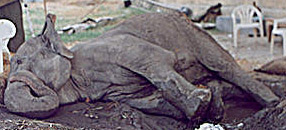

An elderly female elephant has died of grief at an Indian zoo after the death of a close friend.
Damini, who was 72, had befriended a younger pregnant elephant called Champakali at the Prince of Wales Zoo in
Lucknow. But she starved herself to death in misery when Champakali died in childbirth.
Their zookeeper is mourning the loss of his two charges. "It will take me some time to get over the death of my two
loved ones," said her keeper, who goes by the name of Kamaal. The two elephants became inseparable in September
after Champakali was brought in pregnant from Dudhwa National Park where she had worked carrying tourists.
She was in Lucknow for maternity leave, and Damini immediately became her best friend and surrogate mother.
According to animal experts, this kind of deep attachment is common among elephants, with older ones often taking a
mothering role.
"Elephants are very social animals. They can form very close bonds with others in their social group," said Pat
Thomas, curator of mammals at the Bronx Zoo in New York City.
But when Champakali died giving birth to a stillborn calf last month, Damini lost all interest in her food and began
starving herself to death. Zoo officials said she shed tears over her friend's body, then stood still in her enclosure for
days.
Over the next 24 days she barely nibbled her diet of sugar cane, bananas and grass until her legs swelled up and she
collapsed.
She then lay still, losing weight and crying, she stopped eating or drinking her daily 40 gallons of water, despite the hot
weather. Her keepers tried to keep her cool by building around her a makeshift tent of fragrant grass and spraying her
with water. Vets tried to save her by pumping more than 25 gallons of glucose and vitamins into her veins, but she
died on Wednesday. Kamaal has now buried her next to her friend.
"In the face of Damini's intense grief, all our treatment failed," said Dr Utkarsh Shukla, the zoo vet.
My point in adding this two year old story?
NEVER think that animals don't love, hurt, grieve, suffer, know.
"If I learned anything from my time among the elephants," writes the scientist Douglas Chadwick:
"it is the extent to which we are kin. The warmth of their families makes me feel warm. Their capacity for delight
gives me joy. Their ability to learn and understand things is a continuing revelation for me. If a person can't see these
qualities when looking at elephants, it can only be because he or she doesn't want to."
Excerpted from:
When Elephants Weep: The Emotional lives of Animals
by Jeffrey Moussaieff Masson and Susan McCarthy
Ringling often touts its elephant-breeding center by publicizing pregnancies and births, but circus officials did not announce Kenny’s death. His corpse was hauled away from the Coliseum in a rental truck. Ringling later paid $20,000 to settle USDA charges of failing to provide veterinary care to a dying baby elephant.
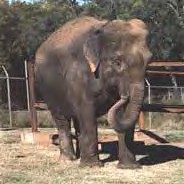
Heartbreaking..Man's Inhumanity never ceases to amaze me....
Source: Peta
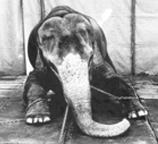
CIRCUS ELEPHANTS
Meet: Hannibal, Romeo & Vance, male circus elephants.
Meet: Benjamin, Kenny, Doc & Angelica, baby circus elephants.
Zoos and facilities like Ringling Bros. and Barnum & Bailey’s “conservation” center breed elephants to ensure a supply of infants for their acts-but not every birth is welcomed. Male elephants may be crowd-pleasers when they’re babies, but they grow up to be extremely unpredictable, often aggressive animals who simply cannot be controlled.
Some facilities will do almost anything to get rid of them.
Source: Peta

in Hohenwald,
Tennessee
Abused Asian & African elephants find a home.
And still growing, more land has been purchased
including a 25 acre lake,
and three African elephants to arrive in 2004
"To leave the world a bit better... To know even one life has breathed easier because you have lived... This is to have succeeded." Ralph Waldo Emerson |
Source: The Elephant Sanctuary

~
Africa's Forest Elephants
called separate species

August 2001
By Will Dunham
~
African Elephant Specialist Group
The African Elephant Specialist Group (AfESG) is a group of technical experts focusing on the conservation and
management of African elephants. Members are actively involved in some aspect of elephant conservation and/or
management. The broad aim of the AfESG is to promote the long-term conservation of Africa's elephants and, where
possible, the recovery of their population to viable levels.
Captive Animals Protective Society (CAPS)
The Captive Animals' Protection Society (CAPS) was established in 1957. Founder Irene Heaton was appalled
by the suffering of animals within the entertainment industry, and campaigned tirelessly on their behalf throughout the
rest of her life. CAPS is opposed to the use of performing animals in circuses and wishes to see animal circuses
outlawed. CAPS seeks to prevent the use and exploitation of captive and performing animals, and investigates cases of
alleged cruelty against captive and performing animals in circuses, zoos, and the entertainment industry.
Elephant Information Repository
For elephants & elephant lovers: the elephant information repository is an in-depth resource for elephant related
news, elephant events, and a trunk full of elephant related information.
Elephant Nature Park
Danger, the opening sound of a trumpeting elephant may startle the heck out of you!
Elephant Orchestra
The elephants that paint are also those that play in the Thai elephant orchestra, a fundraising entertainment for player and listener alike.
Endangered Species
Source: World Wildlife Fund
Asian
Elephants
The Asian elephant (Elephas maximus) has been an integral part of the culture, religion and economy of the
Asian peoples for at least 4000 years. Ironically, this charismatic species today faces a serious crisis that is largely
unrecognized by the global conservation community. The population of Asian elephants today stands at between 35,000 and 50,000 in the wild with an additional 15,000 in captivity, a total population which is less than 10% of its
much publicized cousin, the African elephant (Loxodonta africana).
Friends of the Asian Elephant
Living with Elephants
Dedicated to relieving conflict and competition between the African Elephant and human populations in Botswana. We
do this by identifying sources of conflict, developing strategies for resolution and offering educational programs which encourage a harmonious relationship between elephants and people.
Pachyderm
Pachyderm is a bi-annual international peer-reviewed journal that deals primarily with matters related to African
Elephant and Rhino conservation and management in the wild. It is also a platform for dissemination of information
concerning the activities of the African Elephant, the African Rhino, and the Asian Rhino Specialist Groups of the IUCN Species Survival Commission (SSC). All Pachyderm issues and articles that have been posted on the web to date, starting
from Issue 29 (July - December 2000), are accessible from this page.
Save The Elephants
Save the Elephants (STE)
approaches conservation from an elephant’s perspective. We believe elephants deserve special respect from
humanity because they are sensate beings with a higher order consciousness, and we intend to safeguard their future
in an increasingly insecure world.
The Elephant Sanctuary
In Hohenwald, Tennessee.
Acres and acres for elephants to roam, ponds to bathe in, a heated barn, an ele cam, no visitors. This is my favorite place in the whole world. The first time I watched the EleCam I saw three elephants, out in the open, laying down, sound asleep in the sunshine, natural pond nearby, no worries. I realized it was something I had never seen before and I was overwhelmed. My throat tightened, goose bumps popped up, tears came. This is exactly the way I would love to see ALL animals live. This is exactly the way I believe they should live.
~
|
The Third Well (click for pictures) From: The Elephant Sanctuary... Jody@JodysJungle.com has been an avid supporter of the Sanctuary for some time now. Not only has she provided the funding to drill a well, she has also provided the funds for a solar pump to operate the well. This well will be drilled in Barbara's favorite area of the Sanctuary. It will be christened ~Well Jody~  Thank you Jody, for your continued support. The Elephant Sanctuary in Hohenwald, Tennessee 8/6/2001 |
~
The Urban Elephant
Learn more about
the plight of Asian elephants. Discover how thousands of elephants are living out their lives far away from their homes.
~
Travels With Tarra
by Carol Buckley
Co-founder of
The Elephant Sanctuary in Hohenwald, Tennessee
What happens when you fall in love with a three-foot-tall, 700-pound infant covered with thick black hair?
Carol Buckley was a college student, studying exotic animal care, when she looked up from her homework one day to see a baby elephant walking past her house. The local tire dealer had bought the tiny elephant as a promotion gimmick for his store and was taking her for a stroll. Carol quickly volunteered to help care for and train Tarra, tried to meet the baby elephant's emotional and social needs, and ended up buying her.
Illustrated by dozens of photographs, Carol's 28-year odyssey with Tarra is the fascinating story of a lifetime commitment to an elephant, but it also asks us to reconsider the real need of captive wild animals.
Hardcover
Designed for grades 3 - 7
40 pages
$17.00
~
Call Nancy
Surprise the ele girls with a gift of fresh fruits and vegetables.
Call Nancy at 1-800-231-9574 and your order will be delivered to the Sanctuary.
~
What do you give an elephant?
No chains no performing no confinement no audience no beatings no fear...

Real earth trees ponds friends space love and a heated barn.
These are the best gifts for an elephant.
The Elephant Sanctuary
is a 501(c)(3) non-profit
organization.

|
Fair Use Notice: These documents (JodysJungle.com) may contain copyrighted material whose use has not been specifically authorized by the copyright owners. I believe that this not-for-profit, educational use on the Web constitutes a fair use of the copyrighted material (as provided for in section 107 of the US Copyright Law) |
